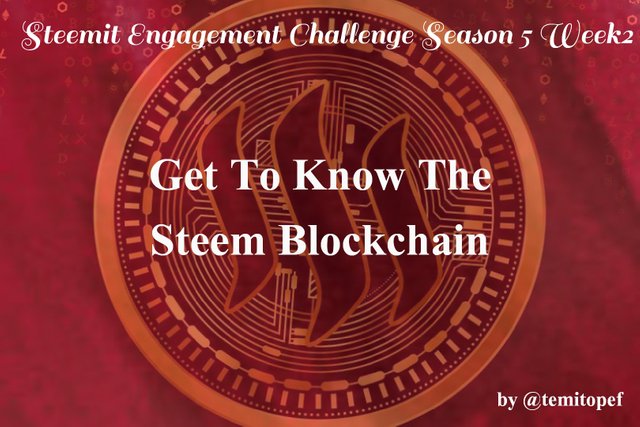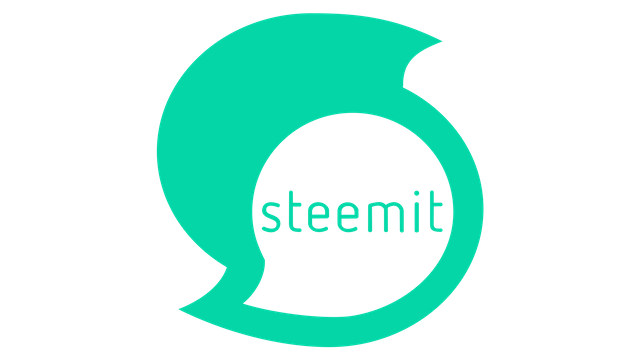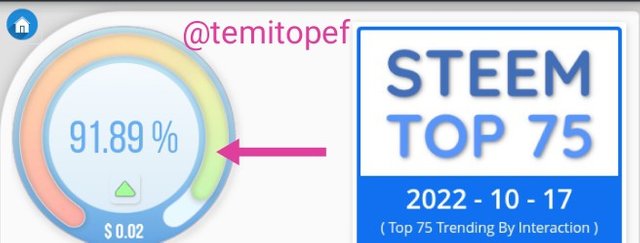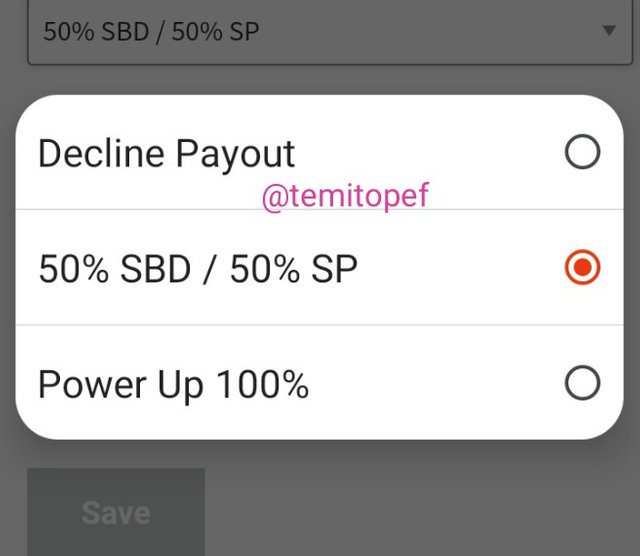
Cover Image Created using Poster Maker
Good day, Steemians. I'm happy to be back in the crypto academy for the second week of season 5 in the engagement challenge. The topic before us today says Get to know the Steem blockchain and I will be writing about the things I know about the Steem blockchain today.
Discuss the consensus protocol used in Steem, Proof of Delegated Participation. What are the differences between DPoS and PoW?
Bitcoin blockchain was the first blockchain that was created as a native platform for the Bitcoin cryptocurrency in Jan 2009 by the group or person whose identity remains hidden, and it uses the PoW consensus algorithm. Many blockchains were created after it.
Steem blockchain is one of the blockchains that were created after the existence of the Bitcoin blockchain. It was created in the year 2016 by Ned Scott and Daniel Larimer. Steem blockchain was developed with a different vision because it is an incentive-based blockchain to host decentralized social media platforms to reward people for original and useful content they create.
.png)
Steem image taken from Wikimedia commons
Furthermore, instead of the consensus algorithm used in the Bitcoin blockchain which is PoW, the Steem blockchain uses the (DPoS) Delegated-Proof-of-Stake that gives every member of the community the opportunity to participate in the governance of the Steem blockchain, to vote for witnesses who they think are capable to keep the blockchain running.
Delegated-Proof-of-Stake can also be defined as a blockchain consensus algorithm that allows stakeholders on the blockchain to elect delegates or witnesses into the position where they validate transactions, secure the network, make rules to progress the blockchain and many others. DPoS is known to be more scalable and consumes less power.
On the Steem blockchain where DPoS is used, there are 21 witnesses, and one of them is a backup witness. These witnesses are elected into the position by the stakeholders who have the opportunity
to 30 votes and can be used to vote for 30 different witnesses they wish to. This is why Steem power is important on the Steem blockchain because it gives us influence.
Difference between DPoS and PoW
Consensus Model: DPoS works on a stake weighty mechanism to select witnesses that validate transactions and secure the blockchain but in PoW, it involves setting up mining machine by the miners to solve computational equations before passing transactions.
Power Consumption: DPoS requires low power for validations by the witnesses while PoW requires excessive power consumption for mining which is not eco-friendly, some Bitcoin stations in many countries have been banned for this reason.
Governance: DPoS is truly democratic but stakeholders with large stakes have more influence and this may lead to more centralized power which in some cases may be dangerous for the security of the blockchain. PoW remains one of the most secured consensus algorithms that prevent the gathering of many interconnected people, mining is set up by anyone without influence from any stakeholders.
How often does a block occur in Steem and how many tokens does it use? Discuss this topic
As I explained earlier at the beginning of this post that one of the works of witnesses on the Steem blockchain is to validate transactions. So each verified transaction is recorded in a block and on the Steem blockchain, the block time is 3 seconds which means that every 3 seconds, new blocks are added by the witness selected to add the next block.
Furthermore, with the 21 witnesses on the Steem blockchain, this means that for every 3 seconds of block production, 20 blocks would be produced in about 1 minute or 60 seconds and overall 10,512,000 blocks is produced annually. So this means that the Steem blockchain is more scalable than Bitcoin which has 10 minutes block time.
How many Token does it Produce or Use?
The block time of Steem as I explained before is 3 seconds and for each of these block times, 3.1 steem tokens are produced, in other words, each time a new block is added, 3.1 new steem tokens are minted, this can be calculated using the formula, ((Virtual supply multiplied by the current inflation rate) divided by the annual block production)).
Also, the creation of these Steem tokens started in 2016 with 9.5% annual inflation rate and decreases by 0.01% for every 250,000 blocks produced on the Steem blockchain. The whitepaper of Steem says that the inflation rate decreases by approximately 0.5% yearly until it drops to 0.95% when the Steem token will be very scarce and cannot be easily earned again. The new tokens are distributed to the Steem community that includes the content creators and curators, stakeholders, and witnesses.
Furthermore, for the new Steem tokens, 75% of it is distributed to the reward pool, this is where the author's reward comes from that is shared between both the author and curators, 15% to Sp holders and the proportion one gets depends on the amount of her SP and 10% to the witnesses for their work on the blockchain. Steem is the native currency of this blockchain and also uses SBD which is a stable coin as a debt asset to control inflation on the Steem blockchain, I will talk about them and how they are earned below.
Do you know what was the first application to run on the Steem Blockchain? Discuss this application
My answer to this is Yes, I know the first decentralized application on the Steem blockchain and it is Steemit.
.png)
Steemit Logo taken from Wikimedia commons
Steemit is a blockchain-based decentralized social media platform that is built on top of the Steem blockchain and it is the first DApp to be running on the blockchain after it was created. The Steem blockchain is incentive-based and this approach is what was used for Steemit so that people can write articles on their blogs on Steemit and earn incentives. It was launched on the 24th of March 2016.
The native token of the Steem blockchain is Steem. Steemit as a decentralized social media platform allows users to post original content of their own, valuable content without containing plagiarism at all. Articles are rewarded through votes which is like an acceptance of a quality post and that process adds value to the post, the voting value on a post depends on the voting power of the curator which is dependent on how much Steem power they have.
The voting has percentages out of 100% a curator can use and the voting mana depletes by 2% after each full 100% vote given out to posts and the mana recharges by 20% daily, there is also a down-voting feature to show disagreement on fake posts and the ones that are intended to steal people's key on the blog.

Voting mana screenshot from my account on Steemworld
Furthermore, the tokens that a user can earn on the Steemit platform are Steem, SBD (Steem-backed dollar), and TRX. When posts are created on Steemit, it pays out after 7 days and at that expiry no votes can add value to the post again, so when the post pays out, the rewards on it are shared on 50%/50% ratio which means 50% goes to the author and the remaining 50% to the curators that voted on the post before the seven days expire.
Authors can also choose how to receive their rewards by setting posts to Power up 100% which pays out in SP, 50% SBD/Steem and 50% SP and decline payout, it can be set before posting. The TRX reward was integrated after the Tron foundation acquired Steemit and an equivalent amount of SP received on a post when it pays out is the same amount of TRX that is received by the authors and curators, this is how the TRX reward has been received since.

Reward setting screenshot from my account on Steemit
Steemit uses the Proof of Brain model to reward authors. As I said earlier, both authors and curators can earn on the post and the allocation of these rewards is from the 75% of the new tokens from block production that enters the reward pool.
Also, the steem wallet is a component of Steemit where the rewards go, it can be used to exchange tokens in the internal market and the SP can be used to receive vesting rewards and vote for witnesses. The tokens can also be sent to other exchanges. Steemit has made social media space more interesting with incentives earned on one's original posts.
What is Proof of Brain (PoB)?
Proof of Brain (PoB) is a model used by most decentralized social media platforms to express how rewards are distributed to people. It is also an expression of the social value of a content before it can be passed to other elements that fulfill the Proof of Brain (PoB) and this also includes incentivization.
Furthermore, there are processes that are involved in the Proof of Brain (PoB) before the model plays its purpose fully. The first here is the creation of original posts that have a very good value to pass across to the community, then the community acceptance of the content and attestation to its quality. On other social media platforms when you find something useful, you like them but through the PoB model, you vote to add value.
Also, voting adds value to the post which depends on the stake weighty mechanism, the Steem power of the curator, and then to the reward pool where rewards are finally allocated as incentives to be shared between both the author and curators.
So the Proof of Brain (PoB) model involves quality content, social value, community acceptance, voting through the stake weighty mechanism (SP), and rewards allocation from the reward pool. These must be completed to fulfill the PoB. Proof of Brain is a model used by Steemit where you must be an original owner of the quality posts you share before they can be rewarded.
Conclusion
Steem blockchain is the first of its kind which is social media-based to allow the development of decentralized apps that can enable people to earn incentives for their original and quality posts through the Proof of Brain (PoB) model. The reward pool that distributes rewards to the posts is made up of 75% of the total new tokens from block production on the Steem blockchain.
Furthermore, the Steem blockchain uses the Delegated-Proof-of-Stake (DPoS) consensus algorithm which involves the election of witnesses into the 21 positions for active work. The operation of the Steem blockchain is eco-friendly because it doesn't consume power excessively like PoW. I'm grateful to the academy for bringing this topic about the Steem blockchain.
Greetings, as always, @Temitopef you never cease to amaze me with your amazing crypto knowledge. You have indeed written a self-explanatory piece which I must say I am impressed with as always. Good luck my friend.
Downvoting a post can decrease pending rewards and make it less visible. Common reasons:
Submit
Thank you for reading my post friend.
Downvoting a post can decrease pending rewards and make it less visible. Common reasons:
Submit
You have presented this post in a very good way. I like the way you have expressed the understanding about the Steem blockchain and the consensus protocols, DPoS and PoW. Yes, DPoS is much more secure and scalable than the Proof of Work mechanism.
Yes, I agree with you. The Proof of Brain actually ensures the quality of the content that is shared on the platform and supported by the curators. Both, the curators and authors have to use their brain capacity and skills to ensure the Proof of Brain.
Thanks a lot for sharing your precious post with us and I wish you a very happy contest ahead.
Downvoting a post can decrease pending rewards and make it less visible. Common reasons:
Submit
Thanks for passing some time on my post to leave a good comment.
Downvoting a post can decrease pending rewards and make it less visible. Common reasons:
Submit
Hello friend dear,
Wow 😲 just as usual you have written so wonderfully and intelligenly, indeed your post is very very educative and I really appreciate that you have shared it with alot of people.
Delegated-Proof-of-Stalk is an advanced consensus mechanism used in the crypto technology and because of Steem team hard work, steem is one of the famous Blockchain technology using Delegated-Proof-of-Stalk consensus mechanism. The Delegated-Proof-of-Stalk consensus mechanism is a consensus mechanism that has most features that are lacking in other consensus mechanism used by other Blockchain technologies whether old or young.
Thank you very much for sharing, please you can check my own entry here
wishing you success
Downvoting a post can decrease pending rewards and make it less visible. Common reasons:
Submit
Thank you for sharing on my post.
Downvoting a post can decrease pending rewards and make it less visible. Common reasons:
Submit